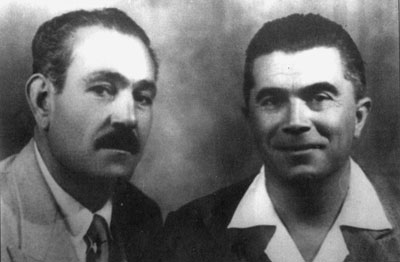On November 8, 1926 was published in the "Official Gazette" the decree that established the "Special Tribunal for the Defence of the State" and "Commssioni provincial allocation to the Border Police." But even before the decree many anarchists were relegated to those remote islands in the Mediterranean that had already been used at the end of ‘800 to keep collected (and isolated from the outside world) the subversives.
At the confino, the anarchists formed a compact group and always fighting, and knew how to fight the fascist dictatorship even in harsh conditions. Just think of the prison sentences of 152 political prisoners who suffered in 1933 in Ponza organized protests against the continued harassment of the direction of the prison, numerous, among them convicted anarchists (Failla, Grossuti, Bidoli, Dettori, etc.).. The following year the anarchist Messina, confined to Ustica, slapped the director of the colony that would require him to make the fascist roman salute. The rebellion against such abuses is progressively extended to other islands, particularly in Ventotene and to tremble, leading to new convictions against our comrades.
United by common bonds of solidarity, anarchists succeeded in reaching and clandestinely circulated among the comrades some anarchist literature and supported at the same time lively debate with the other confined. Particularly tense relations were always confined between communists and anarchists as the first, loyal to the policy directives from the Party and Moscow, became more active to prevent the political activity of libertarians. To exacerbate this controversy came, in 1936, the Spanish news from the front, which, although not precisely, reported armed clashes between anarchists and Stalinists.
 |
Taranto, 1947. Arturo Messinese and Alfonso Failla, two of
the anarchists protagonists of the confineds struggle
against the imposition of the roman salute |
Rebels to any authority, anarchists held constant behavior proud and determined, and were always considered the most dangerous and seditious by the authorities of confinement, this terrible (and deserved) fame was at the senior echelons of fascist persecution and imprisonment because of new and often elongation of the sentence of confinement without even a semblance of trial. It so happened that some of these comrades, although initially sentenced to a few years, had to remain on the islands until 1943, when, with the fall of fascism in July, they were "demobilized".
Significant in this regard the settlement of the confino of Ventotene, which concentrated a large number of anarchists. When news came of the fall of fascism the first to be freed were militants of Justice and Freedom, Catholic, Republican and Jehovah's Witnesses, so at first remained in Ventotene only communists, socialists and anarchists. But when the Marshal Badoglio Roveda called on the government for the Communists and the Socialists Buozzi, they demanded and obtained the release of prisoners, communists and socialists, neglecting anarchists and Slovenia nationalists. So they broke that bond of solidarity, beyond the polemics, that had always linked the various communities across political boundaries to the common fascist enemy. Although some activists of Left parties were trying to refuse to go to not only let the anarchists, the bulk of confined went free, heedless of those who were forced to remain on the island. Anarchists, after ten days from the departure of others, were transported by ship and then by train to the concentration camp Renicci of Anghiari (Arezzo). During this long trip transfer many comrades tried to escape, eluding the close supervision of police officers and carabinieri, but only one succeeded in doing so. When you step in the anarchists had to struggle with the authorities and our two companions were immediately segregated in the cell, and this gave the boot to the protests and the continuous agitation of the anarchists (among which include Alfonso Failla, whose testimony is given below ) who came to clash violently with the police field. Subsequently, however, some managed to escape and went up to the first partisan bands surrounding areas. Only in September the guards melted and left the field, just before the arrival of the Germans.